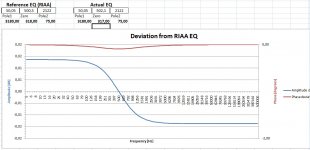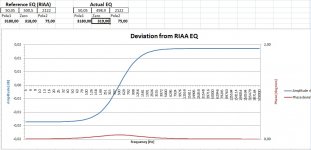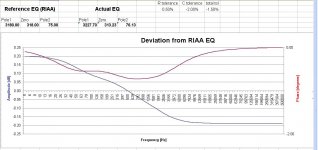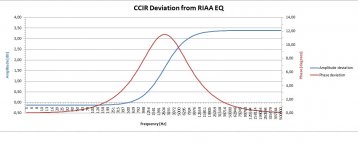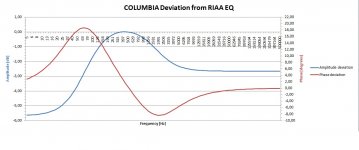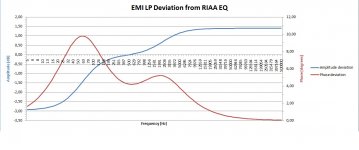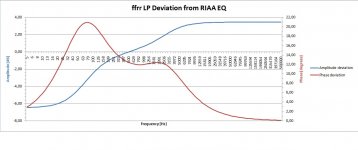Hi,
I have not made an Adjustable EQ version of the El Cheapo. I am only suggesting that due to it's semi-split RIAA EQ it is much easier to make variable than classical 'single shot' designs.
AMR's Phono stage uses three stages (but a design that is overall non-inverting) and fully passive RIAA.
As written in our notes, we essentially set up the Phono stage for the RIAA EQ Curve in "normal" mode and then apply suitable parallel combinations of resistors and capacitors to adjust the curves to be what we want for other EQ options, switched in using some really nice signal relays.
Ciao T
In your El Cheapo design, do you vary resistors only or do you also vary capacitances to modify the curves ?
I have not made an Adjustable EQ version of the El Cheapo. I am only suggesting that due to it's semi-split RIAA EQ it is much easier to make variable than classical 'single shot' designs.
AMR's Phono stage uses three stages (but a design that is overall non-inverting) and fully passive RIAA.
As written in our notes, we essentially set up the Phono stage for the RIAA EQ Curve in "normal" mode and then apply suitable parallel combinations of resistors and capacitors to adjust the curves to be what we want for other EQ options, switched in using some really nice signal relays.
Ciao T
Are you using Excel 2003? Then you need to add the Analysis ToolPak. Here are the istructions from Microsoft:How does one use it?
If I change the 50us RC to any other value, the calculation page shows gobble de gook.
1.On the Tools menu, click Add-Ins.
2.In the Add-Ins available list, select the Analysis ToolPak box, and then click OK.
3.If necessary, follow the instructions in the setup program.
Excel 2007 already contains the Engineering fuction library that handles complex functions.
Using this spreadsheet, just by moving the 318uS zero a little we get the following diagrams:
Using 317uS (502.1Hz) the sound presents less attack and is softer.
Using 319uS (498.9Hz) the sound presents more attack and becomes nasal.
The numbers do not do justice to the real effect that is really noticeable.
Using 317uS (502.1Hz) the sound presents less attack and is softer.
Using 319uS (498.9Hz) the sound presents more attack and becomes nasal.
The numbers do not do justice to the real effect that is really noticeable.
Attachments
Hi Miib,
you can easily do that.
Just copy the first and second sheet to positions 3 & 4.
Go in and change the labeling and change the EQ to the correct RC time constants.
Placing everything or a selection of multiple outputs on one reporting page/diagram takes a bit more excel skill, but still do-able.
you can easily do that.
Just copy the first and second sheet to positions 3 & 4.
Go in and change the labeling and change the EQ to the correct RC time constants.
Placing everything or a selection of multiple outputs on one reporting page/diagram takes a bit more excel skill, but still do-able.
Using this spreadsheet, just by moving the 318uS zero a little we get the following diagrams:
Using 317uS (502.1Hz) the sound presents less attack and is softer.
Using 319uS (498.9Hz) the sound presents more attack and becomes nasal.
The numbers do not do justice to the real effect that is really noticeable.
There are some problems with your assessment:
You changed a capacitor for a value different in just 40pF and IN THEORY this just moved the pole in 3.2Hz, a minute amount.
You claim that the effect is really noticeable.
Problem 1: Just moving your head 5cm from your listening position would wildly change the effective frequency response of your system in more than 2dB at several frequencies. This is something ignored by most audiophiles but something that is well known by the people who work optimizing speaker placement and doing compensation of room modes.
Problem 2: To do a "scientifically correct" listening test, you would need to do a blind test with an ABX box.
Problem 3: Let's say there REALLY is a noticeable effect and it's coming out from the circuit itself. Then this effect is not due to a 3.2Hz change in said RIAA pole but by some more complex interaction/effect that is going on in your specific circuit. Am i explaining myself clear enough? It would not be the 3.2Hz change the thing that is making a supposedly huge difference to the sound, but another electrical effect inside your real-life circuit with real-life capacitors.
Because you were assuming that your capacitors are ideal and that their capacitance in your circuit will *only* move the time constant and do *no other* effect in the circuit.
There are some problems with your assessment:
Am i explaining myself clear enough?
Indeed, but I am not the only one to have experienced the effect of the mods I suggested, so it is not so ugely correlated with my circuit.
It works the same way in severall different circuits and heard by people far apart.
There are some problems with your assessment:
You changed a capacitor for a value different in just 40pF and IN THEORY this just moved the pole in 3.2Hz, a minute amount.
You claim that the effect is really noticeable.
Problem 1: Just moving your head 5cm from your listening position would wildly change the effective frequency response of your system in more than 2dB at several frequencies. This is something ignored by most audiophiles but something that is well known by the people who work optimizing speaker placement and doing compensation of room modes.
Problem 2: To do a "scientifically correct" listening test, you would need to do a blind test with an ABX box.
Problem 3: Let's say there REALLY is a noticeable effect and it's coming out from the circuit itself. Then this effect is not due to a 3.2Hz change in said RIAA pole but by some more complex interaction/effect that is going on in your specific circuit. Am i explaining myself clear enough? It would not be the 3.2Hz change the thing that is making a supposedly huge difference to the sound, but another electrical effect inside your real-life circuit with real-life capacitors.
Because you were assuming that your capacitors are ideal and that their capacitance in your circuit will *only* move the time constant and do *no other* effect in the circuit.
I forgot to add:
Problem 4: You changed a capacitor for a value different in just 40pF. But capacitors can be wildly varying in tolerances, even 10% of tolerance is not unusual. You can use a capacitance meter, but measuring capacitance of just picofarads is not easy at all... just putting two wires close together will already create capacitance of a few pFs.
RCruz, i don't want to claim that you are deluding yourself; if you hear a difference, maybe there is a difference. What i find hard to believe is that the ONLY real difference in your preamp was a 0.05dB change. I think that something more is going on inside your preamp, or that the change was not really just a 40pF difference in capacitance.
Anyway, the topic was equalization curves and the supposed use of non-standard EQs even on stereo records...
Maybe my ears are extra sensible 
Maybe others can not hear any difference. I know a guy that owns a Forcell and can not hear any differences between using the stock very special arm cable and an ordinary supermarket wire.
Another guy started recently a discussion on Linkedin stating that he works in a pro studio an can not hear any differences between cables.
I also know a local amp builder that can not hear any difference between chinese low cost carbon resistors and naked Vishays.
Maybe others can not hear any difference. I know a guy that owns a Forcell and can not hear any differences between using the stock very special arm cable and an ordinary supermarket wire.
Another guy started recently a discussion on Linkedin stating that he works in a pro studio an can not hear any differences between cables.
I also know a local amp builder that can not hear any difference between chinese low cost carbon resistors and naked Vishays.
You can hear everything....!! even the slightest change, but sometimes what you hear is not only because of the change...Type of resistors...Type of caps...all is possible and does make a change to what hear..
How you pour copper on PCB ...size of PCB..everything has influence..But not always in the way we think-- as per example my speakers change more profound by changing type of capacitor, than if I adjust the level in the crossover region by 1 dB. Have a hard time understanding this, and maybe we are not supposed to understand it all....!!
How you pour copper on PCB ...size of PCB..everything has influence..But not always in the way we think-- as per example my speakers change more profound by changing type of capacitor, than if I adjust the level in the crossover region by 1 dB. Have a hard time understanding this, and maybe we are not supposed to understand it all....!!
Not only in Riaa's.. Music rythm and tone...is something that lies deep rooted in us.. how would you else explain that babies dance before they walk. and the music evolved on different continents fits each other both tonally and rhythmically..
As humans we have somethings in common we like the same things.... rhythm and tone...think that different caps have different tone's and thus have different ways of portraying what is going on..tiny tonal shifts that has nothing to do with amplitude or frequency content...more like how deep the colors are, not if it's yellow or blue...don't know how to put it or how to find the handles that gives more music, but i do know that finding the balance's is a matter or trying and finding a path.
As humans we have somethings in common we like the same things.... rhythm and tone...think that different caps have different tone's and thus have different ways of portraying what is going on..tiny tonal shifts that has nothing to do with amplitude or frequency content...more like how deep the colors are, not if it's yellow or blue...don't know how to put it or how to find the handles that gives more music, but i do know that finding the balance's is a matter or trying and finding a path.
- Status
- This old topic is closed. If you want to reopen this topic, contact a moderator using the "Report Post" button.
- Home
- Source & Line
- Analogue Source
- RIAA Equalization Standard...
